Sharon’s 30 years living with MPN
Sharon MacIntyre was young when she diagnosed with MPN at the age of 18 but she believes her first symptoms started many years earlier, when she was at primary school.
“It’s been a long road and it’s been very bumpy,” said Sharon, now 48, who lives on Brisbane’s northside and is the mother of three healthy children.
“I’ve had various specialists and various trials and tried platelet apheresis and all sorts of things.”
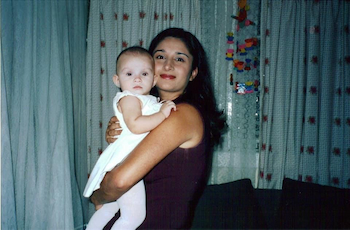
Early records show her platelet counts were elevated, at around 700 as a 10- to 12-year-old, although nothing like the 1900 that they were at the time of her diagnosis. Her red blood cell count was also high and, as a pre-teen, she had “heaps of headaches and nosebleeds” and was “constantly at the hospital for being underweight”.
“My dad’s answer back then was to give me children’s chewable disprin which was probably a good thing as it was helping to stop clots and probably saved me from having a stroke,” said Sharon.
In her last years of high school, along with a lot of headaches and feeling dizzy, Sharon had “strange symptoms” which she described as “funny-down-one-side symptoms”, and most times she couldn’t see, or walk, or talk. It was thought she had very severe migraines. She saw GPs and neurologists, but no one could help.
Sharon repeated year 12 because she’d had a lot of sick days, “and funnily enough”, she had lots of sick days during her second year 12 as well.
Diagnosed with polycythaemia rubra vera and essential thrombocythaemia in 1991
“Finally, someone suggested doing a bone marrow biopsy,” said Sharon, after two successive blood tests showed high platelets. She was then diagnosed with polycythaemia rubra vera (PV) and essential thrombocythaemia (ET) during her break after finishing school and before starting college, in December 1991.
“That was a bit of a shock. I was really young and there was no internet back then, so you couldn’t do Dr Google,” she said.
“And being diagnosed with something that usually affects people over 60 was quite scary for the medical people involved as they didn’t know the long-term effects of the current treatments.
“I went along to the haematologist and I recall him saying he’d never seen anyone so young diagnosed with ET and PV.”
She was put on baby aspirin and hydroxyurea (Hydrea®).
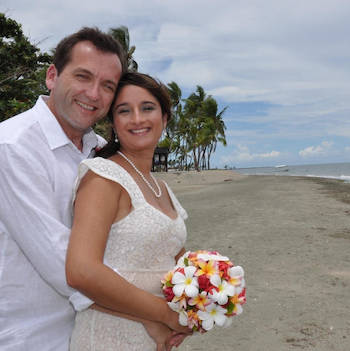
Sharon and Stewart were married on the beach in January 2014
“I went about life as a young person, knowing my limits about the things I could and couldn’t do but often I’d cancel on things if I knew my body couldn’t last the duration or I was having major headaches or dizziness at the time.”
After graduating with a Certificate of Business Management, Sharon went on to QUT and did a Bachelor of Business majoring in international business.
“All that time, I was driving my dodgy old car over to the PA Hospital and seeing my haematologist there once a month.”
A couple of years later, in 1993-94, Sharon stopped taking hydroxyurea and went on a clinical trial which involved daily injections of alpha interferon.
“I can’t honestly remember how that trial went. I think I stopped it because of the side effects, which included feeling fluey.”
Being pregnant and on hydroxyurea was challenging
“In September 2000, I got married and then fell pregnant,” said Sharon.
At the time, she’d been on hydroxyurea for “seven or eight weeks”.
“That was a really emotional and challenging journey. My first haematologist refused to treat me unless I terminated the pregnancy,” she said.
“I was really upset and got a couple of second opinions.”
She chose a haematologist with experience treating an MPN patient in the UK who had been pregnant and, as soon as Sharon decided to go ahead with her pregnancy, she stopped her hydroxyurea treatment.
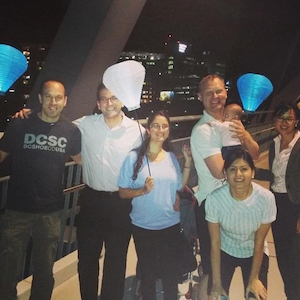
During her pregnancy, Sharon went to the clinic for high-risk pregnancies at the Royal Brisbane Hospital and her obstetrician would page down her haematologist who attended each of her antenatal appointments.
“He’d make sure everything was okay with my blood,” said Sharon.
“Treating a person with MPN who was pregnant was fairly new for both of them. They were monitoring me so closely.
“We didn’t know what the Hydrea could have done or the risks of the MPN itself, like with clots or haemorrhaging.”
“The pregnancy was a bit stressful, I had blood tests and ultrasounds every fortnight, and everyone was being a bit cautious.”
There was great relief when Sharon’s daughter, Bethany, now aged 19, was born and “turned out to be perfectly normal”.
“And I should mention that while I was pregnant all my platelets and other blood counts normalised, and that happened in all three of my pregnancies,” said Sharon, whose other two children are Benjamin, 18, and Amelia, who is seven.
Sharon’s MPN symptoms were monitored on watch and wait
After Bethany’s birth, Sharon went on ‘watch and wait’ and her symptom burden was monitored.
“I’ve always been on aspirin. That’s the one constant, since 1991, except if I’m having an operation or for two weeks before the delivery of the children.
“Other treatments have been added in as my symptom burden got worse and worse, so when my platelet count got higher and higher and I experienced more headaches or dizziness.
“I did try anagrelide, but it caused a lot of side effects, so I wasn’t on it for long,” Sharon explained.
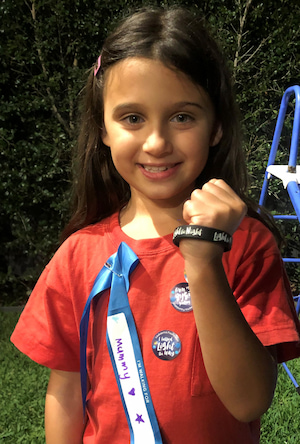
“After the anagrelide, I fell pregnant with my second child and because the first pregnancy went reasonably well, my blood tests and ultrasounds were spaced out to every four weeks.
“That one went quite well and again my platelets dropped to the high normal range while I was pregnant, and after Benjamin was born they went back up, almost instantaneously – within a week or two. It was quite bizarre.
“And each time this happened I remember thinking, ‘I wonder if there’s something in this as a cure. Why is pregnancy normalising things?’
“Benjamin was born fine, and I guess there wasn’t the complication of me being on hydroxyurea or anything to affect the foetus, or developmental stuff like that.”
After Sharon’s second haematologist moved to another hospital, she saw her third haematologist “for a long time”.
“And around the time my son was at kindy, 2006, I tried platelet apheresis but that didn’t work for me, so I only tried it once. Within a couple of days my body had made all those platelets again.”
In 2007, Sharon separated from her first husband who didn’t seem to understand her needs as an MPN patient.
“He was just not helpful. With my MPN, and tiredness, and the two kids, and working, and trying to do everything, it got to the point where he wouldn’t even take out the bins. Everything was just all on me. It didn’t work.
“We had to go through lawyers and the Family Court. It was pretty hard emotionally, physically, and financially,” said Sharon, and it was the following year that myelofibrosis showed up in her bone marrow.
In 2012, Sharon met up again with a former colleague, Stewart, who she had sat next to at work back in 2000.
“He was divorced, and I was divorced, and we seemed to get along, so that was a good thing,” said Sharon.
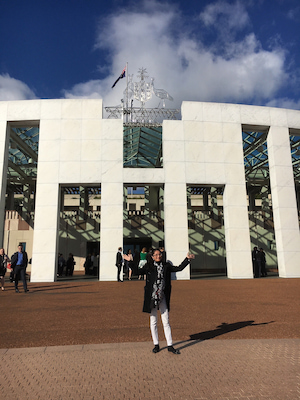
During Sharon’s pregnancy with her third child, in 2014, again, she didn’t have as many blood tests or ultrasounds as she’d had while expecting Bethany and Benjamin, but she was still seen at the high-risk clinic.
“The other difference is, I was older,” said Sharon.
“I was 40 when I fell pregnant with Amelia, so there were a few complications, in that regard rather than the MPN, and a high chance of a foetal abnormality.
“We had to pay $900 for a genomic blood test that was sent to America and I think my MPN had an impact on the results because it came back saying the baby had Down syndrome and Patau syndrome, because trisomy 21 and trisomy 13 showed up in that test result.
“Then I had an amniocentesis which showed my baby was perfectly normal and was a girl. The hospital said I must have one of those conditions, and I said, ‘well clearly, I don’t have Down syndrome and there’s no way I have Patau syndrome either, so I think that it’s my MPN that’s throwing out the test.
“We could have saved money and all this angst. I remember I was visibly starting to show, and we hadn’t told anyone about the pregnancy at that stage because we were really worried and didn’t think we would go ahead [with the pregnancy] if there were a lot of issues.
“When the results from the amniocentesis came back, I called my husband and he was just shocked, saying ‘are you sure, are you sure it’s normal?’”
Sharon’s transformation to myelofibrosis
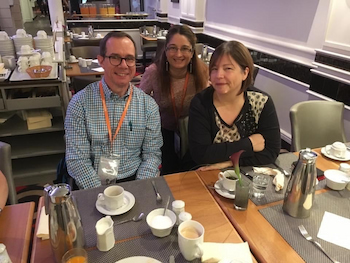
Sharon continued to go “on and off hydroxyurea”. It was the treatment she tolerated the most and which gave her the best results in dropping her platelet count.
“Over time, my PV blended into the background and the focus was more on the ET because my platelets were up around 1900.”
Sharon’s level of fatigue during her third pregnancy was “insane, like nothing I’d experienced before”, and after having Amelia, she noticed her symptom burden was much heavier.
That was in 2014-2015 and Sharon didn’t know it at the time, but these symptoms were due to her MPN transforming to myelofibrosis (MF).
“Everything just hurt. Trying to turn on the taps hurt, opening the baby food jars hurt, and I said to my husband, ‘I think something’s changed’.
“I had another bone marrow biopsy – my sixth or seventh,” said Sharon.
“By this stage, this procedure was really starting to hurt and I wasn’t recovering from them well, so I haven’t had another bone marrow biopsy since 2015.
“It definitely showed fibrous tissue and I got another opinion from another haematologist who I still currently see.
“He looked back through my records and told me I had post-ET myelofibrosis; it was present in my last two bone marrow biopsies, unbeknown to me.
“But it’s lucky and unlucky in a way, because if I’d known in 2008 that I had myelofibrosis, I probably wouldn’t have agreed to having another child with Stewart.
Not on any treatment and managing
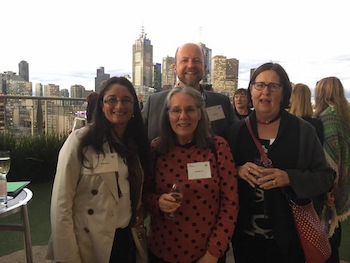
Since then, Sharon has continued to be on watch and wait. She hasn’t been on any treatment and regularly sees her fourth haematologist.
“He suggested at one stage, when my symptoms and platelets were really high, doing hydroxyurea again, but I said ‘no’.
“I just didn’t want to feel dreadful, and I didn’t want to have mouth ulcers and stomach ulcers,” said Sharon about the side effects she’s had in the past on this medication.
“And we’ve talked about ruxolitinib [Jakavi®] and any other trial drugs, and I’m not quite eligible yet.”
Sharon’s haematologist also talked to her about HLA tissue type matching, “in case I need an allogeneic stem cell transplant”.
“I’m not at that stage yet and I don’t have a donor match as yet unfortunately,” she said. Her only sibling is unsuitable as a related donor and no unrelated matches have been picked up on the Australian and international bone marrow registries.”
Sharon has negotiated with her haematologist for her appointments to be every eight weeks, which she said, “is brilliant, with three kids and working and everything”.
What she struggles most with is “the tiredness and the lethargy and the headaches and the bone pain”.
“And my concentration is not like a normal person’s, due to the lack of sleep and pain,” she said.
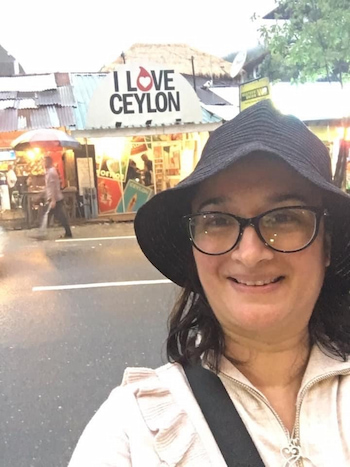
“Thank goodness, my husband is a good helpful husband. He does a lot, so I’ll hang on to him.
“But I’m constantly sick. That’s the worst thing about having MPN – if there’s anything out there, especially during winter, I always get it. So my husband might come home with a cough and I end up in emergency with whooping cough.
“I’ve noticed the main difference between having an MPN and someone who’s healthy is… your system just isn’t working properly and can’t handle infection and can’t handle things that are a bit different to the ordinary.”
For the last 20 years Sharon has worked part-time, doing project work for the Queensland Government. When she spoke to MPN News, she had been on unpaid leave since May, recovering from a broken shoulder “and to get on top of my health and help my son who’s been quite unwell”. She plans to return to her job in late November.
Just getting ready and getting to work is an ordeal for Sharon.
“I would get to work exhausted from getting to work.”
“My GP suggested I apply for a disability parking permit and that came through thank goodness. Being able to park near the train station cuts out so much pain from the extra time and extra walking getting to work.”
“It’s been a bit of a journey, the last three years.”
Sharon’s platelet counts have stabilised
In 2015, “when everything was just declining”, Sharon’s best friend flew out from the UK and they went to an ayurvedic health retreat together for a week.
“That was really insightful,” she said.
“At that retreat, there was no caffeine, no alcohol, no sugar, no microwaving anything. Everything was organic and grown on their farm at Kin Kin. I was having green smoothies every day and non-processed, natural food, and oh my gosh, it was delicious.
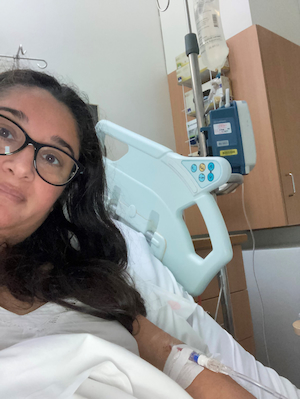
“It was probably good for anyone’s system, but it seemed to work on my blood counts.
“When we came back, my haematologist was like, ‘what have you been doing?’.
“My blood had stabilised – it has stopped worsening and my platelets have been hovering around the 600-700 range since, so I’m just watching and waiting.
“I’ve generally tried to stick to that retreat’s philosophy although it’s hard with three children because it meant nothing white – no white bread or white vegetables. Everything has to be dark, leafy stuff or dark vegetables.”
Sharon compromises with a “bit of a blend – brown rice, brown bread, sweet potato” for her and white potatoes for the children.
Since going to the ayurvedic retreat, Sharon has also been to a cancer cure retreat, “but that wasn’t for me”.
“It was raw foods only and it seemed to clog me up and give me chronic impacted bowels.”
MF, COVID and the future
Sharon talks of her future as being “good and not so good”.
“Good that my kids are getting older so they’re more independent and that’s less of a physical burden on me,” she said.
“Not so good in a way. I realise myelofibrosis is a bit of a debilitating condition.
“Especially when COVID hit, it really scared me. I went straight out and did my will and power of attorney and just thought, “oh my god, if the normal flu brings me down and to hospital, what’s COVID going to do? And my specialist was quite firm that I get the vaccine straightaway.
“I got AstraZeneca even though I’m under 50, because there wasn’t any age limit when it first came out, and I ended up in hospital for four days. Every symptom you can think of, I had.
“I was very reluctant to get the second jab but I had it and I had nothing… not one symptom after the second injection.”
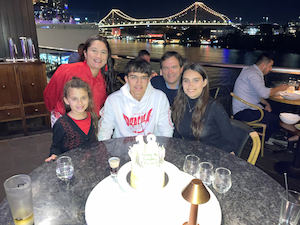
Leukaemia Foundation support
It was when Sharon’s third child was a baby that she first went to the Leukaemia Foundation’s MPN coffee and chat support group meetings in Brisbane, but then “it just got all too hard, with three kids”.
“I didn’t go again until a couple of years later and then I went pretty much every time they held the group, until COVID.
“It’s definitely a vital, valuable service. For so long, especially when I was 18, I never met anyone who had the same thing as me, apart from at the hospital waiting room, especially those who was around the same age as me.
“And as much as your partner is supportive, they don’t get what you’re going through. And sometimes everything is a mess and you put on a smile, but nobody sees all the pain and exhaustion and fatigue.
“You might be able to slap on a bit of makeup, but it’s taken you a few hours to feel good enough to do that.”
Sharon has taken part in the Leukaemia Foundation’s annual Light the Night event a few times and she was among the top 10 fundraisers in Queensland in 2017.
“I made Light the Night cookies and cupcakes and sold them at my work and my husband took a batch in to his work to sell. We raised about $1500.”
This year, Sharon, along with friends and their children took part in this year’s Light the Night, with a walk around her local park and a barbecue afterwards and her fundraising total was $900.
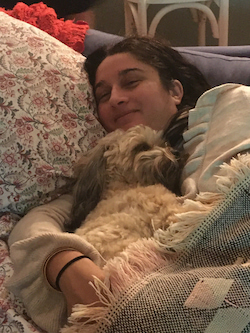
Being informed about MPN
“When I was diagnosed at 18, I thought, ‘okay, this sounds weird’, but I just went on with my life,” Sharon explained.
“I probably should have researched back then, but I just did my studies and went to uni, then got a job.
“Then, when my symptoms got worse and information became available on the internet, I’d look things up.”
In 2017, Sharon went to an MPN conference in Germany “that was brilliant” and she’s also been to MPN events in Sydney and Melbourne, and has communicated by email with Professor Ruben Mesa and has spoken with Professor Dr Claire Harrison – both leading world authorities on MPN.
“I learned so much and I had so many questions from my own research. There’s so much going on – there’s the CRISPR technology for gene editing, immunotherapy, and hopefully some smart person will discover something that cures MPN.
“Getting to those information conferences is hard – especially if you’re working – and expensive, but there are so many benefits for MPN patients from participating,” said Sharon.
“You realise you are not the only person going through this and you get to meet others with similar conditions. You hear their stories and about the treatments they have tried, which you may not know about and which you can then discuss with your haematologist.
“And there are so many MPN experts there that you can chat to, one-on-one. And I usually take my latest blood test and bone marrow biopsy results with me.”
Advice to others
Based on her experience at the beginning of her MPN journey, Sharon says, “if you’re still getting symptoms, keep pushing for an answer”.
“And get support early and reach out for help,” she said.
“When I felt like I was having a bit of a breakdown, the biggest help was talking to my GP and then her saying, ‘look, why don’t we try and apply for this disability parking permit?’’
“Talk to people who are going through something similar and diagnosed with something similar or the same, it’s really valuable.
“Also, try to live a normal life but know your limits.”
Last updated on March 12th, 2023
Developed by the Leukaemia Foundation in consultation with people living with a blood cancer, Leukaemia Foundation support staff, haematology nursing staff and/or Australian clinical haematologists. This content is provided for information purposes only and we urge you to always seek advice from a registered health care professional for diagnosis, treatment and answers to your medical questions, including the suitability of a particular therapy, service, product or treatment in your circumstances. The Leukaemia Foundation shall not bear any liability for any person relying on the materials contained on this website.